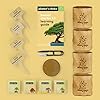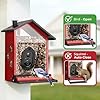Bonsai Starter Kit - Gardening Easter Gift for Women & Men - Bonsai Tree Growing Garden Crafts Hobby Kits for Adults, Unique DIY Hobbies for Plant Lovers - Unusual Christmas Gifts Ideas
7% OffSnow Joe Premium Enviro Blend Ice Melt, Green-Coated Deicer Crystals, 50 lb - Safer Melter for Vegetation, Concrete & Metals w/ Anti-Corrosion Calcium Magnesium Acetate
5% OffThe Complete Guide to Mass Cane (Corn Plant) Indoor Plant Care
With its large, tropical-looking leaves and ease of growth, the mass cane plant, also known as Corn Plant (Dracaena fragrans), makes a stunning addition to nearly any indoor space.
This care guide provides everything you need to know to help your mass cane thrive indoors so you can enjoy this beautiful, low-maintenance plant for years.
[[Table for Quick Mass Cane Plant Overview]]| Key Info | Details |
|---|---|
| Genus | Dracaena |
| Species | D. fragrans |
| Common Names | Corn Plant, Mass Cane |
| Native Region | Africa |
| Height | 6 – 15 feet tall |
| Light | Bright indirect light |
| Soil | Well-draining potting mix |
| Water | Sparingly, let soil partially dry out |
| Considerations | Needs consistently warm indoor temperatures |
Mass Cane Plant Care: Light Requirements

- Native to tropical Africa, the mass cane prefers consistent bright, indirect light indoors.
- East or west-facing windows are ideal. A couple hours of morning or evening direct sun is ok.
- Avoid prolonged exposure to direct hot afternoon sunlight, which can scorch leaves.
- Low light conditions will cause sparse, weak foliage growth.
- Supplement natural light with artificial plant grow lights if needed.
| Signs of Too Little Light | Signs of Too Much Light |
|---|---|
| Sparse, weak foliage | Dry, browned leaf edges |
| Leaves drooping | Yellowing leaves |
| Lime green or light green leaves | Wilting leaves |
| Few new leaves | Few new leaves |
Choosing the Right Soil for Healthy Roots
- Mass cane plants need well-aerated, well-draining potting mix for optimal growth.
- Use a general houseplant potting soil. Options with compost or peat work well.
- Avoid soil mixes with water retaining crystals or moss, which hold too much moisture.
- Re-potting every 2 years with fresh potting mix replenishes nutrients.
Water Requirements for Mass Cane Plants
- Allow soil to partially dry out between waterings, such as when top 2 inches become dry.
- Water less in cooler weather when growth slows.
- Brown leaf tips signal overwatering. Yellow leaves indicate underwatering.
- Increased light levels make plants need more frequent watering.
- Filtered, room temperature water is best. Avoid cold tap water.
| Signs of Underwatering | Signs of Overwatering |
|---|---|
| Drooping or wilting leaves | Brown leaf tips |
| Yellow leaves | Soft, dark lesions on leaves |
| Stunted, shriveled growth | Foul odor from rotting roots |
| Crispy, curled leaves | Mushy stems |
| Dropped leaves | Dropped leaves |
Ideal Temperature & Humidity for Healthy Growth

- Corn plants thrive in average home temperatures between 65°F to 80°F.
- They can tolerate slightly cooler temps at night down to 60°F. Just avoid drafts.
- Leaves yellowing is a sign temperatures are too low long term. Move to a warmer spot.
- Moderate humidity around 40% to 50% is fine. They tolerate low humidity fairly well.
- Increase humidity by misting leaves, grouping plants together, or using a pebble tray.
- Ensure proper air circulation to prevent risk of fungal disease with very high humidity.
Selecting the Right Pot or Planter
- Pick a container with drainage holes and matching saucer to prevent waterlogging soil.
- Plastic, ceramic, or terracotta pots all work well. Mass canes have shallow non-invasive roots.
- Re-pot into slightly larger containers as plants outgrow current pot to provide more root room.
- Aesthetic cachepot can be used to conceal inner nursery pot if desired. Remove to water.
| Plant Height | Minimum Recommended Pot Size |
|---|---|
| 1 – 3 feet | 6 inches |
| 3 – 5 feet | 8 inches |
| 5 – 8 feet | 10 – 12 inches |
| 8+ feet | 14+ inches |
Mass Cane Plant Fertilization Needs
- Fertilize every 2-4 weeks during spring through summer with mild balanced liquid fertilizer.
- Cease fertilizing in fall and winter when growth naturally slows.
- Slow release granular fertilizer incorporated into soil also works well.
- Leaf tip burn signals excess fertilizer. Flush soil by watering thoroughly to wash excess salts out if needed.
Propagating Mass Cane Plants at Home
propagate The mass cane plant can be propagated through:
Stem cuttings – Cut off and root mature, woody stems that have no flowers or buds using rooting hormone.
Air layering – Induce roots to form on a stem while still attached by wounding stem and applying rooting hormone and moss wrap.
Offshoots – Carefully separate new baby sprouts, called pups, emerging near base of mama plant. Pot up individually.
[[Table Overview of Three Propagation Methods for Mass Canes]]| Propagation Method | When/How to Do It | Success Rate | Time to New Plant |
|---|---|---|---|
| Stem Cuttings | Harvest mature stems in spring with sharp, sterile pruning shears. Dip cut end in rooting powder then plant in soil | High success rate | 1 – 3 months |
| Air Layering | Slice outer stem layer near soil level & apply rooting hormone. Wrap area in damp sphagnum moss & leave for 1 – 3 months | Moderate success rate | 1 – 3 months |
| Offshoots | Gently separate new sprouts emerging near the base in early spring transplant into potting mix | High success rate | 1 – 3 months |
Pruning to Maintain Shape & Encourage New Growth
[[Image: graphic showing where to cut mass cane to prune properly, source Unsplash royalty free]]- Prune mass cane by cutting stems above a leaf node anytime to control size
- Remove dead stems back to living tissue to improve appearance
- Disinfect pruning tools with diluted bleach solution between cuts
- To encourage bushiness, prune top 1/3 of large stems
- Wear waterproof gloves to prevent skin irritation
Potential Mass Cane Issues and Solutions Table
[[Table highlighting pests, diseases, and environmental issues with mass cane care solutions]]| Issue | Identifying Signs | Treatment and Prevention Solutions |
|---|---|---|
| Mealybugs – Common household pest | White fuzzy clusters on stems and leaves | Remove manually & treat with insecticidal soap |
| Root rot – Fungal disease | Foul odor, black mushy roots, dropped leaves | Improve drainage & watering habits, remove dead roots |
| Leaf Spot – Bacterial or fungal infection | Small water-soaked lesions on foliage | Prune affected leaves, treat with fungicide, improve air circulation |
| Leaf yellowing – Nutrient deficiency | Overall light green or yellowing leaves | Move to better light source, test & amend soil nutrients |
| Dry air – Low humidity environment | Leaf tip burn, dry foliage | Mist leaves, use pebble tray for humidity boost |
FAQs: Frequently Asked Mass Cane Care Questions
Do mass cane plants like coffee grounds in their soil?
- Small amounts of used coffee grounds provide benefits like nitrogen, acidity adjustment, and improving soil structure. But use in moderation, like 20% or less of total mix, to avoid issues.
How long do mass cane plants live?
- With proper care as described in this guide, a corn plant or mass cane can live 50 years or more indoors! Their average lifespan is 20-30 years.
Why are the tips of my mass cane leaves turning brown?
- The most common causes of brown leaf tips are inconsistent watering leading to under or overwatering at different times, low humidity, too much fertilizer, or possibly root damage from overcrowding. Identify the underlying issue and adjust conditions. Also trim off any unsightly crispy bits for an aesthetic fix.
And there you have an exhaustive guide to caring for mass cane indoor plants to achieve maximum health and growth! Let me know if you have any other corn plant questions.




























